Chasing Shadows, Part 2
Welcome to the second week of Shadows over Innistrad previews. Last week I introduced the design team and started explaining how the set came to be. Today, I'm going to tell the second half of that story as well as show off two cool new preview cards (and a new noncreature token card). I hope that sounds like fun. On with part two.
Hiding in the Shadows
As we left off at the end of last week, the design had focused on capturing the insanity that was engulfing the world of Innistrad. We had come up with the following mechanics so far:
- Madness—This mechanic, which allows you to cast cards as they are being discarded (often at a lower cost), first appeared in Torment—in the Odyssey block, the first graveyard-centric block—and was brought back in Time Spiral block. The mechanic had a lot of hurdles to overcome, but there wasn't a mechanic that captured the flavor of madness better than, well, madness.
- Delirium—This mechanic was a tweak on threshold (from Odyssey), where cards have two versions, one of which is active if you have four or more different card types in your graveyard. As I explained last week, we experimented with a number of different conditions, but this one (suggested by Ken Nagle) by far played the best.
- Skulk—This is an evasion mechanic that keeps your creature from being blocked by any creature with a higher power. Skulk was designed to be an evasion mechanic that kept you from making your unblockable creature much bigger with Auras and Equipment.
- Double-faced cards—We couldn't return to Innistrad without revisiting the splashy mechanic from the original block. The design team worked hard to find some new space with double-faced cards while also allowing some favorite executions, like Werewolves, to return.
A quick aside about something I briefly mentioned last week: when we decided to return to Innistrad, we spent some time trying to understand what exactly we were returning to. This meant looking back at all the market research about what players loved about Innistrad during its first visit. If you look at the data, Innistrad, the set, is one of the most popular sets we've ever done (with its only real rivals being sets from the two Ravnica blocks). By "popular," I mean both the mechanics and the flavor were well-received.
Dark Ascension scored almost equally on the world (which makes sense, as it was an extension) and slightly lower, but still high, on the mechanics. Avacyn Restored scored lower than both of the first two sets. The Angel theme was very popular and the set sold well, but market research showed that players didn't like the world or mechanics as much. If we were going back to Innistrad, it was clear that we wanted to focus more on returning to where the block began than where it ended. A big part of trying to figure out the story had to do with figuring out how to undo some of what had happened in Avacyn Restored. We needed things to get worse again. Hmm, what if almost everyone, including the protectors of the world, started going mad? End of aside.
So, we had filled up most of the set and had room for one more keyword. Mechanically, we had some things we needed the keyword to do:
- Help with card flow—Something we try to do in every set (although it has become a little easier due to scry becoming evergreen) is make sure there are ways to help players get access to cards. A lot of design is based around creating certain synergies, and we want to make sure the card flow is high enough to help enable these synergies.
- Give players something to do with late-game mana—We try hard to make sure that players, with proper deck building, are able to lower the likelihood of not getting enough mana. One of the tricks to enable this is to let players play a little higher percentage of land and then make sure there are things to do with that mana later in the game. The card-flow mechanic doesn't always help with this, but often it can.
Flavor-wise, we had a different problem. The design team had focused all its energies in capturing a sense of a world going mad. As the story came together, though, it started to take on the properties of a mystery. Jace is our protagonist and he comes to Innistrad and learns that something is going horribly amiss, and he has to figure out why. The madness played an important role, as that was what Jace was trying to understand and stop, but it became clear that the set needed some way to mechanically tie into this sense of mystery. Well, we had one mechanic left. Could we use it to capture both the mechanical and the flavorful needs?
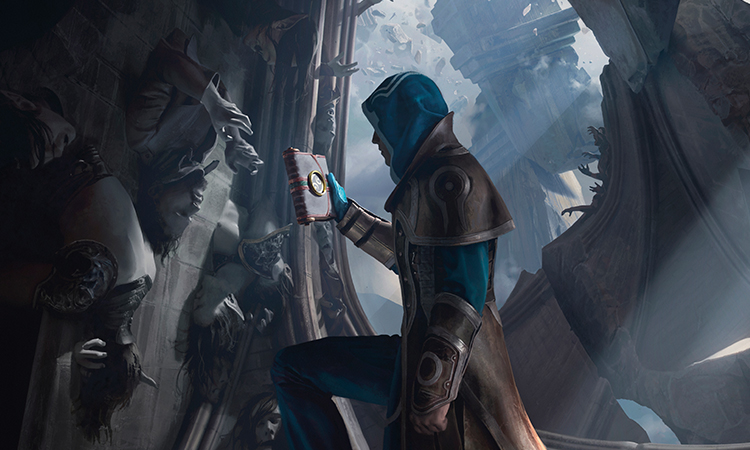
Casting a Shadow
We started by giving the mechanic a name. We wanted to call it "investigate." What exactly would investigate do? Obviously it had to have some tie to card drawing. It helped out the first mechanical need above and it clearly matched the flavor. Investigating would led to more information (aka cards). We experimented with a number of mechanics but ended up with something resembling the "impulsive draw" ability in red (exile a card from the top of your library and then you can cast it until the end of the turn).
We had two tweaks. First, the card(s) exiled from the top of your library was exiled face down. This meant that you knew what you had the ability to cast but your opponent(s) didn't. We felt that added a little mystery. Second, you had until the end of your next turn to cast it. This increased the chance that you'd have enough mana to cast the card(s). The design team played around with our version of investigate for a while and we were pretty happy with it. That is what we handed off to development.
Once development got their hands on the file, they started playing the set and putting the mechanic through its paces. Developers in general are better players, as we recruit them from high-level play. As they played with investigate, they found a problem. The added card was so valuable that you almost always played it. The mechanic was very wordy for what ended up just being a cantrip that forced you to play the card on the next turn.
Dave Humpherys, the lead developer for Shadows over Innistrad, put together a mini design team to see if they could find a replacement. The parameters were similar to design. It wanted to be called "investigate" (to play up the sense of mystery) and it needed to provide card flow, but Dave decided that he could solve the late-game mana sink issue with other cards. The mini-team chose to look to the story for inspiration. One of the little details that had come out in world building was there were a lot of these quirky little bent stone items known as cluestones.
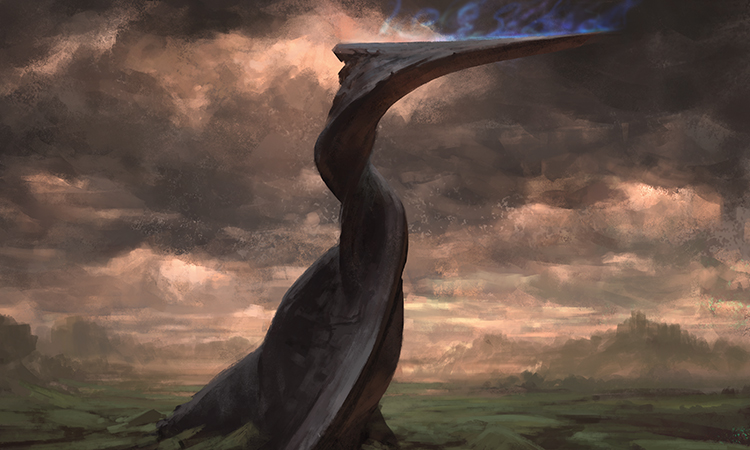
That led them down the path of investigate finding you clues or cluestones. What if investigating created an artifact token? And not just any artifact token, a cluestone? Okay, what would the cluestone, or Clue as it was eventually called, do? The design needed card flow. What if the artifact could be sacrificed to draw a card? The mini-team put a mana cost on it as otherwise it would essentially be just "draw a card" and wouldn't need the artifact. The mana cost was also a knob that development could tweak if they needed.
The mini team liked what they had made and turned it over to development. Dave and his team played with it and also came to the conclusion that they liked it. I think they played around with different mana costs, but two ended up playing the best. It was enough to mean something but not so much that it became hard to get the card.
To get a better sense of how investigate plays, maybe I could show you a card. In fact, maybe I could show you two cards, as I was given two preview cards—both with investigate. So click below to see Tireless Tracker, Ulvenwald Mysteries, and a Clue artifact token.
Click to reveal
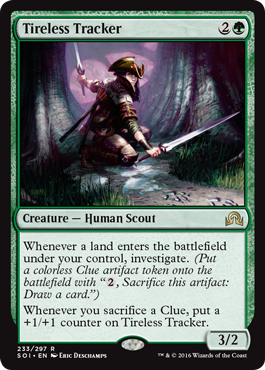
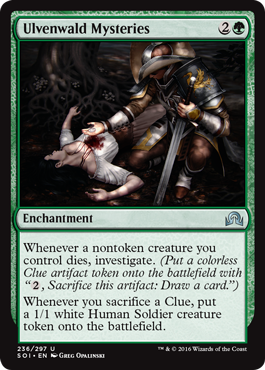
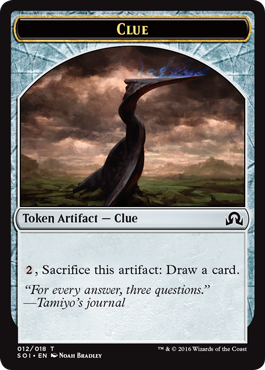
Now that you can see some examples, I can explain a few things. First, "investigate" is a keyword action (a keyword that's a verb), meaning that it's an effect that can be done, sometimes when specific things happen. For instance, in the preview cards, you get to investigate whenever a land enters the battlefield under your control or a nontoken creature you control dies.
Second, we made a number of cards that trigger when a Clue is sacrificed. This is important for several reasons. It makes the decision of when to sacrifice a Clue more interesting. You don't always do it as soon as possible. It creates a linear connection between cards with investigate. There's now a reason why you might want to build a deck with a bunch of them. Finally, it allows us to essentially have Clues do effects other than just drawing a card. If a card that makes a Clue has a sacrifice trigger, then it gets to essentially give the Clue a second effect.
A Shadow of Its Former Self
Investigate was the final keyword, but the design team still had other problems to solve. First up was the tribes. One of the defining elements of Innistrad was that we had four "monster" tribes (Spirits, Vampires, Werewolves, and Zombies) and Humans. Let's go through them one at a time:
Humans—Last time around, Humans were surrounded on all sides by the "monsters" and were doing whatever they could to survive. Certain Equipment was stronger in the hands of Humans. Humans also had a theme of banding together to fight the monsters. This was continued, but a new flavor was added. As madness sweeps the world, Humans are very susceptible, and we get to see them start to go insane. Humans show up in all the colors, but the tribal components are focused in white and green.
Spirits—The Spirits have a tie to the Humans. Once again, Humans dying can generate Spirits. The Spirits mostly fly and have a more controlling feel, as they tend to manipulate things around them. As the world goes mad, the Spirits are feeling the repercussions and are getting trapped in various ways. Spirits are primarily white and blue.
Werewolves—We talked about changing how the Werewolves functioned but decided to stay with the status quo. They are still all double-faced creatures that flip back and forth based on the same criteria as original Innistrad (casting no spells brings the Werewolves while casting two spells in one turn brings the Humans back—for those unaware, the flavor is that there's less activity at night). There are again Wolves that are mechanically connected to the Werewolves to help create enough cards to draft/build a deck. Of all the tribes, Werewolves changed the least. Werewolves and Wolves are red and green.
Zombies—Zombies are still a slow, controlling deck meant to overwhelm the opponent with Zombies in the long game. Zombies are still tied closely to the graveyard and often return from it. While there is still a little "building Zombies" out of dead body parts (creatures) from your graveyard, the theme is emphasized a little less than before. One of the new flavors is that Zombies are the one tribe not affected by the madness that has fallen on the world. Zombies are blue and black.
Vampires—If Werewolves changed the least, Vampires have changed the most. In Innistrad, Vampires were the most aggressive tribe, with an unnamed mechanic that had them get +1/+1 counters whenever they dealt combat damage to a player (what R&D nicknamed the "Slith ability," based on a previous bunch of creatures with the ability in the set Mirrodin). The Slith ability is (almost entirely) gone. In its place is a strong tie to the madness mechanic that appears in black and red, the two Vampire colors. The Vampires of Innistrad are going crazy, and this can be seen through the madness mechanic that shows up on a lot of Vampire cards.
Angels—Okay, this technically wasn't a tribe in Innistrad, but they did show up in force in Avacyn Restored. Our biggest nod to the third set is a higher-than-normal number of Angels, most of which are succumbing to the insanity that is sweeping the world. Angels are primarily white, but things are affecting them in strange ways.
Without a Shadow of a Doubt
The final problem the design team had to work on is a bit more complex, but I'll try to explain. Synergy can work in one of two ways: what I'll call "natural synergy" and "linked synergy." First off is natural synergy, which is when the individual components of a set naturally overlap. Raid, for example, encourages attacking, and morph wants bluffing opportunities. The two mechanics therefore create synergy with one another. You don't need anything but the two mechanics to make the synergy work.
Linked synergy is when the two mechanics don't directly connect but rather can link to each other through shared synergy. For instance, madness doesn't directly tie into delirium, but the two are both synergistic with discard effects. Madness needs discard to work, as it triggers off cards being discarded, and delirium can use discard to help "turn itself on." Shadows over Innistrad is a set with more linked synergy than direct synergy.
The reason linked synergy is harder is because it requires more infrastructure to work. For natural synergy, all you have to do is include the synergistic mechanics and your job is done. With linked synergy, you have to always be conscious of what is linking them together and then make sure you include not just the mechanics but also the linking cards.
Part of designing Shadows over Innistrad was figuring out what the linking components were and then making sure that we not only included them but documented everything so that development would keep the necessary pieces. This is a theme I can revisit once you all know more of the set. I bring it up now because it was another key element of making the design work.
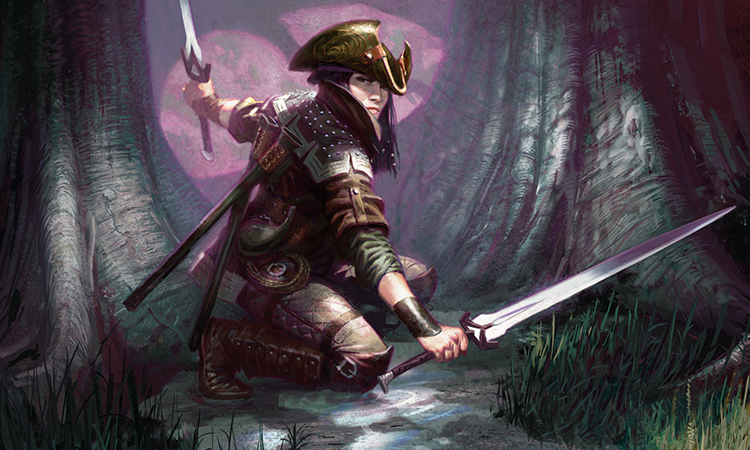
Afraid of Your Own Shadow
That's all the time we have for today. I hope this week and last gave you a better sense of how the design of Shadows over Innistrad was put together. As always, I'm eager for feedback both on this column and the set. You can send feedback to me through email or through any of my social media (Twitter, Tumblr, Google+, and Instagram).
Join me next week when I tell some card-by-card stories about Shadows over Innistrad.
Until then, may you enjoy the net without going mad.
"Drive to Work #314—Getting a Job"
One of the most common questions I get is "How can I get a job in Magic R&D/at Wizards?" On today's podcast I answer that question.
"Drive to Work #315—Collaboration"
Magic is created through teams working together, so in this podcast I talk all about how to work well with others.
- Episode 315 Collaboration (22.3 MB)
- Episode 314 Getting a Job (21.0 MB)
- Episode 313 Limited Edition, Part 6 (16.0 MB)
- Episode 312 Limited Edition, Part 5 (15.9 MB)
- Episode 311 Limited Edition, Part 4 (16.4 MB)

